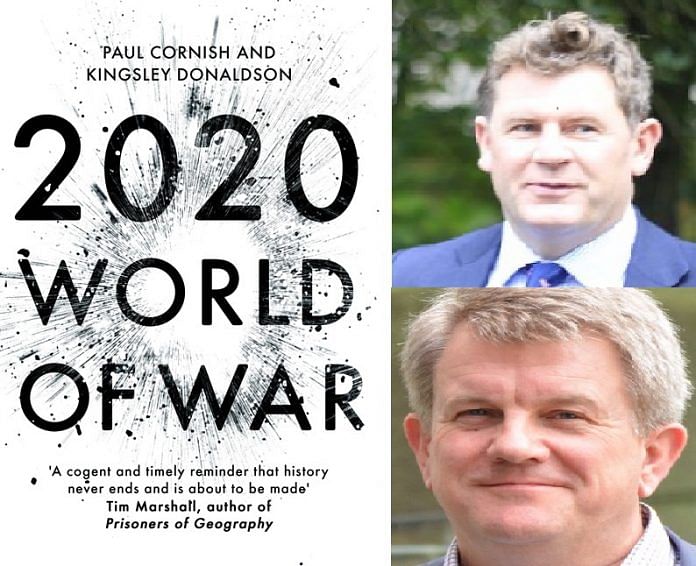Seven scenarios, bookended by three analytical essays on the state of play of international security, are global in scope as well as meticulous in local details.
The year is 2020. In the United States, Donald Trump prepares for the November election by doubling down on his incendiary promises. Trump’s re-election is far from being an impossibility; nativism is now a permanent feature of the political life in the West. In China, a year before the first of the Two Centenaries, Xi Jinping puts finishing touches to his plan to restore the country to its former greatness while its economy enters uncharted waters. With large sections of its military radicalised, Pakistan is in disarray.
Former British army officers Paul Cornish and Kingsley Donaldson’s scintillating ‘2020: World of War’ fleshes out each of these scenarios to depict a world on the edge. But when combined, the effect is frighteningly larger than that of each of the individual scenarios.
With only a few months left before the UK exits the European Union following the 2016 referendum, Britain struggles to contain the fallout from Brexit. South European countries are saddled with debt crises as well as unchecked migration from West Asia following a fresh crisis that stems from an unlikely ISIS-al-Qaeda coalition.
Vladimir Putin sees the chaos and uncertainty in the Eurasian landmass as an opportunity to fine-tune Russia’s hybrid warfare doctrine. The internet of things, unbreakable cryptography, and deep machine learning brings unprecedented ease for millions – which they use for good and ill as they see please.
The locus of the book is undeniably and unavoidably British. Brexit, Russian intransigence, as well as American inattentiveness post Trump large over the entire effort. However the seven scenarios, bookended by three analytical essays on the state of play of international security, are global in scope as well as meticulous in local details. The former adds relevance; the latter richness.
In the hands of Cornish, Donaldson, and their collaborators (three of whom are from the New Delhi-based Institute for Defence Studies and Analyses) the present projects itself into multiple strategic futures where traditional hard security problems are amplified by governance challenges, resource constraints, technological breakthroughs as well as good old short-sightedness of national leaders.
In particular, three scenarios in the book stand out.
In the third chapter of the book, Cornish and Donaldson construct a 2020 where Xi’s planned path to forcibly unify Taiwan with the Chinese mainland passes through an unusual destination: Australia. In this future, Australia’s iron-fisted treatment of refugees, who continue to use Indonesia as a transit point, leads to much bad blood between the two countries.
By 2020, Indonesia has become an ally of China – a shining example of how successful Xi’s economic statecraft has been. Following the sinking of a ship from the Middle East that had transited through Indonesia, Chinese navy deploy off the coast of Australia leading to a face-off between the US navy and the PLA-Navy.
The second scenario – especially unsettling from an Indian perspective – is set in South Asia. Pakistan in 2020 is a state of civil war all but in name, with several officers from its army having defected to the Taliban. Investigations of a string of extremely serious attacks in Kabul in 2020, carried out by a motley of terror groups that include the Taliban, Islamic State, as well as LeT, unearth a plan for a Naqbah – a catastrophic, decisive attack.
While details of the plan are still being uncovered, an al-Qaeda affiliate in Pakistan announces, credibly, that it now has a tactical nuclear weapon in its possession. When it becomes clear that the warhead will be used to destroy the Golden Temple in Amritsar, India contemplates a pre-emptive nuclear strike given that its No-First-Use commitment does not extend to non-state actors.
Plausible scenarios like these that amplify and build on the ‘known unknowns’ is the meat of ‘2020: World of War’. The most remarkable feature, however, is the last scenario in the book: an imperfect storm that brings together a crumbling Middle East, a resurgent al-Qaeda, and a high-tech network of criminals and terrorists running amok in the heart of Europe. Add to this, China and the US find themselves in the middle of a tense standoff over South China Sea, and Russian cyber operations in the Baltic states soon make way for a conventional invasion.
While Cornish and Donaldson describe scenarios that the best Hollywood screenwriters would find hard-pressed to match, the point of ‘2020: World of War’ is not entertainment. As they note in the introduction of the book, strategic planning “demand a protracted engagement with the future in all its uncertainty.”
Military futurists do not pretend to be soothsayers; scenarios are not the future foretold. What they do is push trends that can be discerned in the present to their logical extreme so as to future-proof security strategy. ‘2020: World War’ is a must-read for all who think that might be a good idea.
Abhijnan Rej is a Fellow, Strategic Studies Programme, Observer Research Foundation, New Delhi






